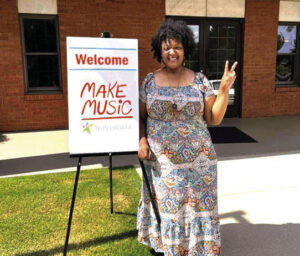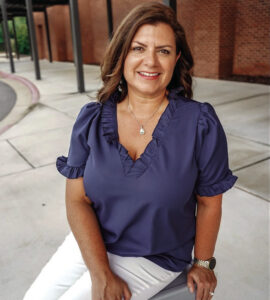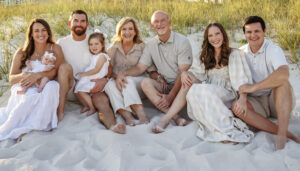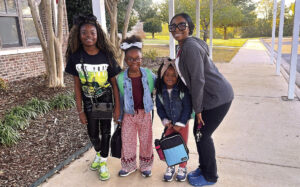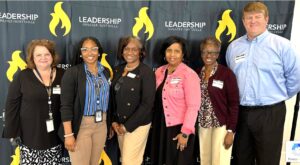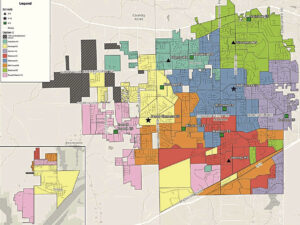John P. Rankin: The history of 127 Church Street, United Methodist Church
This old postcard photo from 1910 had a handwritten caption on the back which identities the church as the Methodist Episcopal Church – South with Reion Allison, Mrs. Gaston (Rev. Gaston’s wife and daughter), Lucile Gaston and “three little Madison girls. We were attending a Sunday School”. Courtesy of John Rankin
By JOHN P. RANKIN
Madison Historian
MADISON – There are some mysteries surrounding the history of 127 Church Street, which is home to the Madison United Methodist Church. There is a period of history concerning the property not solved, nor have historians before me been able to learn all of what happened relative to the property. Some things may have been lost or just not recorded during the Reconstruction era, but here is what is known.
Roland Gooch (1778-1850) not only “belonged” to the Methodist Church, he deeded the first land for the church that was organized in 1828 but now stands at 127 Church Street in Madison. That original location of the church was near his home at the junction of today’s Hughes Road and Old Madison Pike. Of course, back in 1837 when Roland deeded a 1.5-acre plot for the church, there was no Old Madison Pike because there was not yet a town of Madison. The road that we call Old Madison Pike was then just a portion of the older Brown’s Ferry Road that connected Huntsville to a ferry across the Tennessee River.
The ferry site was downriver (northwest) of Decatur by several miles, near Brown’s Island in the river. The junction of the roads was mentioned as “Gooches CrossRoads” and “Gooch’s Corner” in the 1857 minutes of the Madison County Commissioners’ Court. The church situated at the site was similarly mentioned as “Gooches Meeting House”.
Today we recognize the church site as being where a gasoline station and a branch of the Regions Bank are located. The Gooch family cemetery is just about a hundred yards to the north, on a hill behind shops across Hughes Road from the eastern end of Plaza Boulevard. Old Madison Pike was by 1858 known as the Huntsville-to-Triana Pike, including as part of the route down Church Street according to land deeds. Later the route by that name to Triana ran down what is today Sullivan Street.
In 1873 the church was put on logs and pulled by mules to its present location on Church Street in Madison. That location was deeded to the church by Dr. Isaac Fox Deloney for $5. The church trustees were named in the deed as J. W. Farley, G. E. (should be “R.”, not “E.”) Sullivan, L. H. Grubbs, John W. Burton, and G. W. Martin. The lot was mistakenly specified as Lot 13, so the ink in the quill pen must have run out, making the “33” to become a “13” because Lot 13 is out of the question.
The description of the lot’s boundaries fit Lot 33 precisely, as follows: “Beginning at the southeast corner of Deloney Street (now Arnett Street), running westwardly with the street 130 feet to Blakely’s corner, then southwardly to Mrs. Vaughn’s north line, then eastwardly along Mrs. Vaughn’s line to Church Street 50 feet, then northwardly up Church Street 236 feet to the place of beginning, containing 38/100ths of an acre.”
The deed also contained the following stipulation: “The church shall at all times forever hereafter permit such Ministers and Preachers belonging to the church, as shall from time to time be duly authorized by the General Conferences of the Ministers and Preachers of the said Methodist Episcopal Church South, or by the Annual Conferences authorized by the said General Conferences, to Preach and expound God’s Holy Word therein.”
The church became the center of activities in the town for many decades afterward. It was literally the community gathering place for more than just church services. Old minutes and other records of the church are still available from storage on the second floor of the offices. The original one-room frame building of the church was brick veneered in its new location, and the church has grown ever since. It even the parent church of the much larger Asbury Methodist Church congregation of today. Asbury is located back on Hughes Road, about a mile north of the original location and on the west side rather than the east side of Hughes Road, where the original structure was first located.
The old church must have been much loved by Dr. Deloney for him to provide one of the town’s largest lots for only $5 on November 14, 1873, per Deed Book WW, pages 241-2. However, there may have been other reasons for the “gift” of the low price. It seems that the land designated later as Lot 33 and most of Lot 32 in the 1870 plat of the town was originally purchased by James E. F. Bailey in 1857 directly from James Clemens, the founder of the town. This was done before the lots were drawn and platted in 1870 by Thomas J. Taylor.
Mistakes were made in Taylor’s plat, as there was one lot between Lot 31 and Lot 32 that was not even given a number, but it was in fact later owned by Thomas J. Clay. Furthermore, the Clemens deed to Bailey encompassed the entire area of later Lot 33 and the eastern majority of Lot 32. Ownership got terribly confused over the years in this set of lots, beginning with the death of James E. H. Bailey in 1862 from wounds received at the first Battle of Manassas that occurred in July of 1861 in Virginia.
This James E. H. Bailey was the only child of widow Martha (Vaughan) Bailey. who married Hezekiah Bradley Cartwright when his first wife died. Martha produced five more children for Hezekiah to add to the seven children born by his first wife Martha Holden Gray. Hezekiah’s parents were John and Mary (Dillard) Cartwright, so with Dillard, Cartwright, and Gray ancestry, then adding the spouses of his twelve children, Hezekiah was related to many of the Madison-area pioneer families.
Many of the close relatives or descendants of Hezekian Cartwright were quite prominent in the history of Alabama. However, his step-son James E. H. Bailey never married, suffering early death at age 26. His name was engraved at the top of a plaque on the east wall of the Madison County courthouse, heading the list of “Fallen Heroes” of the county.
James was a blacksmith in the 1860 census of Madison. Old accounts of the move of the Methodist Church to the site where it now sits on Church Street stated that there was originally a blacksmith shop on the site, so that can be somewhat confirmed with the census data. James must have been a very good blacksmith, because his 1868 estate inventory showed over 100 accounts still owed to him by almost all of the early settlers of the area.
Altogether, their debts to James amounted to almost a thousand dollars that he had never yet collected when he went away to war and died. Before he left for the war, James bought an acre of land on the west side of today’s Sullivan Street from John D. Tanner on January 7, 1861, just before the war started. John D. Tanner was appointed to be the administrator of James’ estate, with securities on Tanner’s required $1000 bond by Nathaniel Matson Gooch and Thomas M. Green.
While no direct records have yet been located for proof, it appears that James Bailey’s real estate may have eventually passed to his mother’s Vaughan relatives. Widower W. P. Vaughan purchased Lot 33 for $550 from William B. Dunn and W. R. Johnston on September 9, 1867. Yet, there is no record known to show that either Dunn or Johnston had ever purchased Lot 33.
It may be that these two men were somehow appointed to dispose of Bailey’s real estate, and perhaps the Reconstruction period failed to properly record some such things. It is known that Dunn was a physician and highly respected depot agent for the railroad. Johnston became Madison’s first mayor when the town was incorporated after an election in 1869. Just how Dr. Isaac Fox Deloney came into possession of the property upon the death of W. P. Vaughan is unknown, but the confusion did not stop there.
After Deloney sold the lot for $5 to the church in 1873 per Deed Book WW, page 241, more sales continued for the property. Deed Book BBB, page 566, records the Probate Court sale to Joseph B. and Martha A. Leeman by W. R. Johnston at public auction for $500 on December 4, 1875, after the church was supposed to already be established on the site. Perhaps litigation ensued, but no record of the church defending its ownership was found.
The Leemans did mortgage the property four times in the period of 1881-1882, so they may have had difficulty making payments. If they did lose their claim to the property, perhaps the historical tradition of the church move to the site was a decade too early with the date of the rolling logs. Otherwise, Isaac Deloney may not have acted in good faith in 1873 or something else must have happened to cloud the title to the property. It might have been easy to part with the lot at a very low cost compared to its worth on the market if there was a known question on the title being clear.
Litigation against a church would also have been widely viewed in unfavorable light in that period, so it may be that there was no contest in the courts. Whatever happened, Isaac Deloney was a key player in getting the church established on Church Street. His position as Circuit Court Clerk in Madison County in the period 1874-1880 may have played a part in his land sale being upheld.
Dr. Isaac Fox Deloney’s parents were Edward Brodnax Walker Deloney and Margaret Bonner Fox. Isaac was born in 1830. In the 1840 census the family was enumerated in Lawrence County. In the 1850 census the family was in Franklin County, Alabama, under the surname “Delona.” Postings on Ancestry.com indicate that Isaac had three sisters and seven brothers. He apparently never married nor had children of his own.
The Ancestry data shows that Deloney was distantly related to a number of U. S. Presidents and First Ladies, as well as to famous actors, authors, and outlaws. Deloney ancestral roots have included English and French kings and nobles. These even included English king William the Conqueror, born in 1024 in Normandy, France, twenty-nine generations back from Isaac.
At the time of the 1860 census, Isaac was living and practicing his profession in Madison Station. In the census of Madison County in 1870, Isaac Deloney was listed as being a cotton broker, yet he was known to have been a physician before 1857. In that year alone he treated such folks as pioneer Abraham Beadle, his wife, his mother-in-law, and his slaves on what is now Redstone Arsenal lands southeast of Gate 9. Beadle’s probate records show that Deloney made at least six visits to Beadle’s house in just 1857, the year Beadle died. For those visits and the prescribed medications Deloney charged the estate $9.00.
Deloney was a graduate of Tulane University, his specialty given as “allopath.” The 1880 census lists Deloney as a physician living in the home of Lawson and Celeste Comer Clay. Lawson was the youngest son of Governor Clement Comer Clay and his wife Susannah Claiborne Withers, both of whom lived just southwest of the Madison historical district in their early lifetimes before their marriage. The 1900 census records show Isaac Deloney living the household of a niece in Newburg, Franklin County, Alabama. In the 1910 census Dr. Deloney was enumerated in Decatur of Morgan County. In the 1920 census he was listed at age 89, residing in Tuscumbia, Colbert County. Before his death at Leighton of Colbert County in 1923, the census of 1920 listed Deloney as living alone at age 89. He was shown as “single” in every census.
While living in Madison, Dr. Deloney purchased considerable land and several town lots in addition to Lot 33 that he sold for $5 to the church. The additional holdings included original town lots 6, 40, and 42 plus 41 acres northwest of the town’s historic district. Deloney obtained most of these parcels by public auction held at the courthouse in 1868 to liquidate the estate of James Clemens, the Founder of Madison.
As one of his final Madison involvements, Dr. Deloney came back to this county in 1902 to testify in probate court about Bettie Turner’s will that had been entrusted to him in 1879 for safekeeping. He had lost the original will during his moves, but a draft of the will was presented for probate by Annie Wiggins Sanders. Sanders was a niece of William Barham Dunn, Madison’s first railroad depot agent and also a physician.
Bettie Turner was a Black servant and assistant of Dr. Dunn for years. Dunn had given Turner a house and Lot 23 near Front Street’s intersection with Sullivan Street. When Turner died with no known heirs, the draft will (having been originally witnessed by Dr.’s Dunn, Algernon Sydney Harris, and Isaac F. Deloney) became the controlling instrument to pass the property back into Dunn’s family.
The probate court approved the property going to Annie E. Wiggins Sanders, a daughter of Jackey G. Dunn who lived just east of today’s airport after her marriage to Richard A. Wiggins. Jackey was also a sister of brothers John and Dr. William B. Dunn. Agent / Dr. Dunn was a close friend of Dr. Isaac Fox Deloney. In this small town it seems that all lives were closely intertwined.




